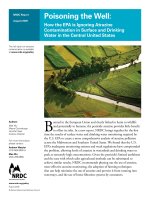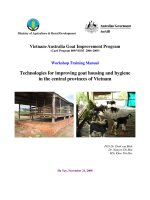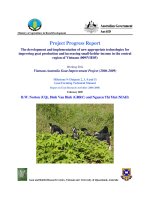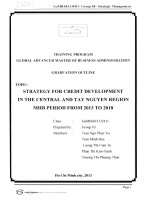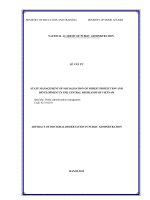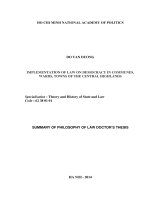Intercropping in coffee farms, new trend for sustainable cultivation in the central highlands
Bạn đang xem bản rút gọn của tài liệu. Xem và tải ngay bản đầy đủ của tài liệu tại đây (173.94 KB, 6 trang )
Vietnam Academy of Agricultural Sciences (VAAS)
Journal of Vietnam Agricultural Science and Technology - No.1(4)/2019
INTERCROPPING IN COFFEE FARMS, NEW TREND
FOR SUSTAINABLE CULTIVATION IN THE CENTRAL HIGHLANDS
Dinh i Nha Truc1,*, Nguyen Vu Ky1,
Phan Viet Ha 1, Hoang i Ai Duyen1
Abstract
e results of survey on intercropping systems in co ee farms in the Central Highlands showed that there were
7 types of intercropping system in which the four most popular were: co ee with durian (Durio zibethinus); co ee
with black pepper (Piper nigrum L.); co ee with avocado (Persea nmericana) and co ee with cashew (Anacardium
occidentale L.). e high density of intercropping plant decreases co ee yield less than 3 tons per ha. Farmers used
unbalanced fertilizer dose of N - P2O5 - K2O ratio and the time of fertilizer application was not right. e amount
of water irrigated for intercropping farm was quite reasonable, the average amount of water used for co ee was
400 liters per tree per time, durian of 250 liters per tree per time, pepper of 100 liters per plant per time, avocado of
300 liters per tree per time. Co ee productivity was less uctuation over the years. Economic e ects for intercropped
farms increased from 1.5% to 300%.
Keywords: Intercrops, economic e ciency
INTRODUCTION
Content
Co ee is one of the key export agricultural products
of Vietnam, in 2017, the area co ee plants of total is
about 643,000 hectares. e average yield of Robusta
co ee is about 2.7 tons per hectare, higher than
the world average yield 3 - 4 times (Department of
Crop Production, 2018). Although there is a high
production and export value but most of area is
belongs to households, they produced monoculture
and intensive cultivation unsustainability. Especially,
a ect of climate change for production like the
Extreme weather phenomenon (drought, El nino…).
e investigation of co ee tree and kinds of
intercroping plant: Area, type of land, slope, planting
year, productivity and production. Management of
varieties (types of variety, source variety). Irrigation
(equipment for irrigate, time, number of watering
times and amount of irrigation water). Fertilizer
(dosage, type of fertilizer, method of fertilizer, time of
use fertilizer). Selling product prices, labor cost, etc.
erefore, intergrated cultivation by intercropping
of economic value plants into co ee farms will be
a solution for suitable production.
e types of
intercropping in co ee gardens will create diverse
products, getting hight income, good biological and
ecological interactions when agricultural market has
many adverse changes ( uong et al., 2001).
Currently, the intercropping of fruit plant with high
economic value has not been evaluated in terms of
science and economic e ciency.
erefore, it is
necessary to study to determine intercropping models
with economic e ciency on co ee production for
ensure sustainability.
Methods
- Establishing questionnaires on the situation,
application of technical measures, management of
co ee and intercropping varieties, criteria to evaluate
the economic e ciency of the model.
- Selecting the survey sample. In each province, choose
2 - 3 key districts had a intercropping in Robusta co ee
plantations for economic e ciency. Interview face to
face with 150 farmers per province to collected data
and then recorded in the prepared form.
- Applying participatory assessment method (PRA)
to provide two-way information exchange with crosschecking to collect accurate information.
- Using Excel and SPSS so ware to analysis data.
MATERIALS AND METHODS
Time and place of the study
Materials
- Location: e study was conducted in the Central
Highlands region including provinces Lam Dong,
Dak Nong, Dak Lak, Gia Lai and Kon Tum.
Robusta co ee farms intercropping perennial cash
crops such as durian, pepper, avocado and cashew;
each farm has area larger than 0.5 ha.
1
*
- Duration: 2017 to 2018.
Western Highlands Agriculture and Forestry Science Institute
Corresponding author: Dinh i Nha Truc, Email: , telephone: 0978 716753.
14
VAAS - YAAS Cooperation on Cross border Economics study
RESULTS AND DISCUSSION
e type of intercropping in co ee plantations
e results of survey on 750 co ee farms in the
Central Highlands showed that there were 7 types
of intercropping system and divided into 2 groups,
including: single intercropping (co ee and one
industrial crop) and multiple intercropping (co ee
and more than two industrial crop).
Single intercropping includes four most popular were
co ee with durian (Durio zibethinus), black pepper
(Piper nigrum L.), avocado (Persea americana) and
cashew (Anacardium occidentale L.).
ere were
644 questionnaires per 750 total questionnaires
(accounting for 85.8%). Multiple intercropping had
107 questionnaires per 750 total questionnaires
(accounting for 14.2%).
e most popular of current intercropping plants
were the durian and pepper, accounting for 72.5% of
the interviews households. e type of intercropping
avocado has only recently developing, accounting for
more than 8.5% of the interviews households. e type
of intercropping cashew type accounts for nearly 6% of
the interviews households. e multiple intercropping
had 13.1% of the interviews households.
Lam Dong province had more types of intercropping
than other provinces in the Central Highlands.
Figure 1. Ratio of types plant of intercropping in the Central Highlands
Technical management method of intercropping
Table 1 showed that production practice had two
main method of intercropping, including: replacing
into co ee tree position follow xed spacing and
planted between four co ee trees with xed spacing
were applied by most farmers, with over 90% of the
interviews households.
e data at table 2 showed that growing co ee with
3 ˟ 3 m spacing was still dominant with more than
69.3% of the households, other distances account for
over 30.7% of the households.
Table 1.
e methods of intercropping popular
(% households applied)
Replace
Planted
Planted
into co ee between four
Intercropping
with
holes
co ee plants
crops
none
with xed
with xed
spacing
spacing
spacing
Durian
46.3
46.3
7.4
Pepper
Avocado
33.3
97.4
55.6
2.6
11.1
Cashew
60.0
40.0
-
In general, some distances popular was planted
according to results of survey: durian and avocado
grown with 2 main spacing were 9 ˟ 9 m and 12 ˟ 12 m,
respectively 33.0%, 14.7% for durian trees and 21.6%,
20.5% for avocado trees . e main plant spacing of
black pepper was still mainly 3 ˟ 3 m (between four
co ee trees with xed spacing, intercropping between
the two co ee lines) with more than 78.1% of the
survey households. e main tree spacing of cashew
was 6 ˟ 6 m and 15 ˟ 15 m.
e survey results of fertilizer at table 3 used by
farmers for Robusta co ee plantations were quite
high, unbalanced fertilizer dosage of N - P2O5 - K2O
ratio and the time of fertilizer application was not
right, the lowest level of fertilizer used by farmers for
co ee was 273 kg N + 130 kg P2O5 + 280 kg K 2O per
hectare, the productivity achieved was 3.1 tons per ha.
Higher amounts of fertilizer at other plant spacing had
not di erence in productivity. However, the trends
of co ee productivity were inversely proportional
to the density of intercropping.
is showed that
interactions of intercropped crops had created shade
to limit forming co ee ower, so co ee could not
maximize the potential yield as pure plantation.
15
Vietnam Academy of Agricultural Sciences (VAAS)
Journal of Vietnam Agricultural Science and Technology - No.1(4)/2019
Table 2.
Types
Co ee
Durian
Pepper
Avocado
Cashew
Spacing
e spacing between crops (% households)
Kon Tum
Gia Lai
Dak Lak
Dak Nong
Lam Dong
Average
3˟ 3 m
57.7
72.9
69.9
70.2
75.7
69.3
Other
42.3
27.1
30.1
29.8
24.3
30.7
9˟ 9 m
21.1
-
71.8
12.8
26.6
33.0
9 ˟ 12 m
15.8
-
2.6
10.3
6.1
8.7
12 ˟ 12 m
10.5
-
-
35.9
12.2
14.7
12 ˟ 15m
-
-
-
10.3
10.5
5.2
Other
52.6
-
25.6
30.7
44.6
38.4
3˟ 3 m
100.0
60.0
80.3
62.5
87.5
78.1
3˟ 6 m
-
-
3.3
6.3
-
1.9
6˟ 6 m
-
6.7
1.6
3.1
12.5
4.8
Other
-
33.3
14.8
28.1
-
15.2
9˟ 9 m
-
-
50.0
25.0
11.2
21.6
9 ˟ 12 m
12 ˟ 15 m
20.0
-
12.5
0.0
11.1
10.9
12 ˟ 12 m
40.0
-
12.5
18.6
11.1
20.5
0.0
-
-
25.0
-
6.2
Other
40.0
-
25.0
31.4
66.6
40.8
6˟ 6 m
-
23.1
-
-
-
23.1
15 ˟ 15 m
12 ˟ 12 m
-
7.7
-
-
-
7.7
-
15.4
-
-
-
15.4
Other
-
53.8
-
-
-
53.8
Table 3.
e amount of fertilizer used for co ee tree and intercropping plants
Co ee
Intercropping plant
Model
Distance
N
(kgha-1)
P2O5
(kgha-1)
Mono co ee
crop
276
160
420
9˟ 9
9 ˟ 12
383
267
272
316
205
259
12 ˟ 12
389
260
12 ˟ 15
377
3˟ 3
3˟ 6
Co ee and
Durian
Co ee and
Pepper
Co ee and
Cashew
3.9
0.71
0.60
0.64
3.1
0.50
0.34
0.39
3.4
300
0.54
0.44
0.44
3.5
254
303
0.48
0.35
0.30
3.2
364
224
268
0.19
0.13
0.14
3.2
273
130
280
0.14
0.12
0.12
3.1
6˟ 6
354
237
127
0.21
0.15
0.20
3.4
310
218
209
0.24
0.18
0.11
3.0
9 ˟ 12
12 ˟ 12
12 ˟ 15
595
217
402
0.72
0.95
0.20
3.3
309
163
326
0.49
0.25
0.12
3.1
370
248
250
0.30
0.17
0.18
3.3
6˟ 6
424
242
193
0.19
0.23
0.15
2.1
12 ˟ 12
376
200
261
0.33
0.33
0.14
2.8
15 ˟ 15
348
97
159
0.30
0.30
0.14
3.2
Note: N - Nitrogen; P2O5 - Phosphorus; K2O - Potassium
16
Mean co ee
yield
(tonsha-1)
9˟ 9
Co ee and
Avocado
K2O
N
P 2O 5
K 2O
(kgha-1) (kg plant-1) (kg plant-1) (kg plant-1)
VAAS - YAAS Cooperation on Cross border Economics study
Co ee plant were irrigated on average from 2.7 to
4.0 times each dry season with the cycle from 21.7
to 31.8 days, the average amount of irrigation water
from 350 to 533 liters per tree per time, the amount of
irrigation water for co ee on intercropping cashew was
higher than other types of intercropping. In general,
comparing with advisory irrigation for pure co ee
plantation (520 liters per tree per time), the amount
of irrigation water for intercropping co ee garden
had decreased signi cantly. Depending on each type
of intercropping plants, there were di erences in the
number of irrigation times, irrigation cycles, and
irrigation water. Average intercropping durian were
irrigated 3.8 times per dry season, about 20 days
per time and an average water volume 250 liters per
tree per time and there were not much di erence for
amount of irrigation water in planting spacing. e
average intercropping pepper was irrigated 5 times
per dry season, cycle of 16 days and average water
volume of 110 liters per pole per time. e average
intercropping avocado was irrigated 3 times per dry
season, cycle of 22 days, the average water volume
290 liters per tree per time. Cashew plant was less
irrigated or not watered.
Table 4. Number of irigation times, cycle and amount of irrigation water
Type of intercropping
Co ee
Co ee and
Durian
Co ee and
Pepper
Co ee and
Avocado
Co ee and
Cashew
Irrigation times
(times)
Irrigation cycle
(daytime-1)
Amount of irrigation
water (litterplant-1time-1
Co ee
Intercropping
tree
Co ee
Intercropping
tree
Co ee
Intercropping
tree
9˟ 9
2.9
4.6
24.1
17.0
434.9
231.1
9 ˟ 12
3.1
3.8
25.5
20.8
429.5
261.4
12 ˟ 12
2.9
3.4
26.7
23.2
404.3
246.0
12 ˟ 15
2.9
3.4
21.7
18.7
357.1
252.9
Aver
3.0
3.8
24.5
19.9
406.5
247.9
3˟ 3
3.4
5.2
27.0
16.7
425.2
90.2
3˟ 6
3.3
4.5
23.3
16.7
337.5
103.8
6˟ 6
3.3
5.3
24.1
14.1
436.7
130.0
Aver
3.3
5.0
24.8
15.8
399.8
108.0
9˟ 9
2.9
3.0
31.8
27.1
395.8
241.7
9 ˟ 12
3.3
3.3
25.0
18.0
407.1
235.7
12 ˟ 12
3.0
3.1
21.7
21.4
381.3
318.8
12 ˟ 15
2.7
2.7
20.0
20.0
416.7
358.3
Aver
3.0
3.0
24.6
21.6
400.2
288.6
6˟ 6
4.0
1.7
21.3
22.0
350.0
100.0
12 ˟ 12
3.3
0.7
30.0
0.0
533.3
66.7
15 ˟ 15
3.5
0.0
25.0
0.0
475.0
0.0
Aver
3.6
0.8
25.4
7.3
452.8
55.6
Productivity and
intercropping crops
economic
efficiency
of
According to survey data in table 5, in areas with
long-time durian intercropping in Robusta co ee
gardens, the e ects of planting distance on co ee
yield. ese spacing of 6 ˟ 6 m, 9 ˟ 9 m, 9 ˟ 12 m,
co ee yield did not reach 3 tons per ha. erefore, it is
not recommended to grow these spacing so as not to
a ect the development of the co ee industry.
According to table 6 showed that, intercropping
durian with 9 ˟ 9 m and 9 ˟ 12 m distances were higher
economic e ciency than two spacing 12 ˟ 12 m and
12 ˟ 15 m. According results table 5 with high density
intercroping had co ee yield not reach 3 tons/ha, with
low productivity negatively a ects sustainable co ee
production. Spacing of intercropping durian with
12 ˟ 12 m and 12 ˟ 15 m had co ee yield from 3.2 to
3.5 tons per ha, economic e ciency was higher than
pure co ee plantation from 75.89 - 96.85%.
17
Vietnam Academy of Agricultural Sciences (VAAS)
Journal of Vietnam Agricultural Science and Technology - No.1(4)/2019
Table 5. Average productivity of durian intercropping in key areas
Intercropping
distance of durian
6˟ 6
9˟ 9
9 ˟ 12
12 ˟ 12
12 ˟ 15
Krong Pak district, Dak Lak province
Co ee beans
Durian
(tonsha-1)
(kgplant-1)
2.5
21.5
2.6
126.4
2.8
57.5
3.2
67.5
-
-
Dak Mil district, Dak Nong province
Co ee beans
Durian
(tonsha-1)
(kgplant-1)
2.7
51.7
2.9
43.2
2.6
57.3
3.2
44.1
3.0
61.3
Table 6. Economic e ciency of intercropping models (Million VND per ha)
Model
Distance
(meter)
Mono co ee
crop
Co ee and
Durian
Co ee and
Pepper
Co ee and
Avocado
Co ee and
Cashew
Yield
Co ee
(tonsha-1)
Intercropping
plant
(kgplant-1)
3.9
9˟ 9
9 ˟ 12
12 ˟ 12
12 ˟ 15
3˟ 3
3˟ 6
6˟ 6
9˟ 9
9 ˟ 12
12 ˟ 12
12 ˟ 15
6˟ 6
12 ˟ 12
15 ˟ 15
3.1
3.4
3.5
3.2
3.2
3.1
3.4
3.35
3.3
3.1
3.3
2.1
2.8
3.2
86.2
77.9
59.6
95.8
2.1
2.7
3.3
55.70
31.6
42.8
44.3
10.5
21.3
34.3
Model of pepper intercroping with a spacing of
3 ˟ 3 m was still co ee yield over 3 tons per ha, but
pepper yield per plant was the lowest among the pepper
intercropping spacing. Pepper with a high density
in co ee gardens have shown to be less sustainable.
ere were many pepper gardens in Lam Dong, Dak
Nong, Gia Lai province e ected quick wilt disease and
slow decline.
e intercropping pepper spacing of
3 ˟ 6 m and 6 ˟ 6 m gave the co ee yield from 3.1 to
3.4 tons per ha, economic e ciency was higher than
pure co ee planting from 100.25 to 120.45%.
For intercropping avocado, all intercropping spacing
have reached co ee yield of 3 tons. However, as
analyzed above, the thick density in the long term will
a ect co ee yield. erefore, it is not recommended
to maintain the thick planting spacing. Decrease
co ee productivity due to increased the density of
18
Total
income
Total
cost
Bene t
86.30
144.70
58.30
126.56
111.58
121.01
129.42
144.92
119.80
141.42
118.62
126.30
97.52
110.24
83.68
97.70
96.09
361.23
310.83
235.78
231.97
306.82
248.32
258.16
269.23
222.60
204.35
191.62
120.70
156.88
175.33
233.03
199.24
114.77
102.54
161.90
128.52
116.75
150.61
96.30
106.83
81.38
63.50
101.51
135.92
(%) increase
compare to
pure
plantation
299.71
241.75
96.85
75.89
177.70
120.45
100.25
158.33
65.19
83.24
39.58
-36.50
1.51
35.92
intercropping have also been reported (Hoa et al.,
2016). So appropriate intercropping spacing for
avocado tree should be 12 ˟ 12 m and 12 ˟ 15 m, co ee
yield and avocado yield were quite good, economic
e ciency was higher than pure co ee planting from
39.58 - 83.24%.
All intercropping cashew spacing had low co ee
yield and economic e ciency was not signi cantly
increased comparing to pure co ee planting.
erefore it is not recommended to intercropping
this type.
CONCLUSIONS AND RECOMMENDATIONS
Conclusions
- e most popular of current intercropping plants
was single durian and single pepper in co ee gardens,
VAAS - YAAS Cooperation on Cross border Economics study
accounting for 72.3% of the households. e type of
intercropping avocado has only recently developed,
accounting for more than 8% of the households.
Multiple intercropping model had above 11.7% of the
households.
- Type of intercropping durian with a spacing of
12 ˟ 12 m and 12 ˟ 15 m for co ee yield of over 3 tons/ha
and durian productivity of over 60 kg per tree,
economic e ciency higher than pure co ee planting
from 75.89 to 96.85%.
- Type of intercropping pepper with spacing of
3 ˟ 6 m, 6 ˟ 6 m for co ee yield of 3 tons/ha and pepper
yield of 2.7 kg per plant, economic e ciency higher
than pure planting from 100.25 to 120.45%.
- Type of intercropping avocado with all spacing
had co ee yield over 3 tons/ha and the productivity
of avocado over 30 kg per tree, economic e ciency
increased from 39.58 to 83.24%.
- Type of intercropping cashew with all spacing had
low co ee yield and economic e ciency was not
signi cantly increased comparing to pure co ee planting.
Recommendations
- On the basis of co ee as the main crop, to increase
income per area unit and ensure sustainable co ee
cultivation, recommending reasonable intercropping,
ensuring the harmonious development of crops, the
average co ee yield is over 3 tons per ha and the
economic e ciency is higher than that of pure co ee
planting.
- Recommending durian and avocado intercroping
with the spacing of 12 ˟ 12 m and 12 ˟ 15 m; pepper
intercroping with the spacing of 3 ˟ 6 m and 6 ˟ 6 m.
e recommended density was the same as in the
intercropping process. It is not recommended to
develop cashew intercroping.
REFERENCES
Department of Crop Production, 2018. Current status
and orientation of intercropping in sustainable co ee
production organized by the Ministry of Agriculture
and Rural Development and the Dak Lak Provincial
People’s Committee, April 19, 2018 in Buon Ma
uot city, documents for conferences.
Dinh
i Nha Truc, Nguyen Vu Ky, 2017.
e
investigation on types of intercropping system of
perennial cash crops in robusta co ee plantations
in the Central Highlands. Sustainable agricultural
transformation project (VnSAT).
Dinh i Nha Truc, Nguyen Vu Ky, 2018. Process of
intercropping pepper, avocado, durian trees in robusta
co ee garden. Western highlands Agriculture &
Forestry Science Institute - Vietnam Academy of
Agricultural Sciences.
Nguyen Xuan Hoa, Dang Dinh Duc Phong, Nguyen
Van Phuong, 2016. Evaluation of agroforestry systems
on co ee gardens in Dak Lak and Lam Dong. Western
highlands Agriculture & Forestry Science Institute.
Vietnam Academy of Agricultural Sciences.
Nguyen Van uong, Trịnh Xuan Hong, Phan Viet
Ha, 2001. Agroforestry systems in Daklak province:
ecological impacts and econnomic e ects. Western
highlands Agriculture & Forestry Science Institute.
Date received: 9/10/2019
Date reviewed: 15/11/2019
Reviewer: Dr. Nguyen Van uong
Date accepted for publication: 22/11/2019
FLOWER BIOLOGY OF BLACK PEPPER (PIPER NIGRUM) IN VIETNAM
Duong
Nguyen Tran Quyen1,*, Tran i Dieu Hien1,
i Oanh , Nguyen Quang Ngoc1, Nguyen i Nhung1
1
Abstract
A study on ower biology of black pepper (Piper nigrum) was carried out to provide important understanding in
ower biology which is vital to breeding and hybridization studies in Vietnam. ree varieties namely Vinh Linh,
Phu Quoc and SRLK have been used for this study. e results showed that it takes about 242 days to 270 days from
spike appearance to fruit ripening. e longest period is fruit development and fruit maturity. Anther dehiscence
of Vinh Linh and Phu Quoc occurs at around 7:00 pm to 8:00 pm. However, SRLK is earlier at 4:00 pm to 5:00 pm.
Sigma receptivity happens 1.8 days to 2.8 days a er anther dehiscence. Stigma remains receptive from 4 days to
6 days and up to 10 days.
Keywords: Piper nigrum, ower biology, anther dehiscence, stigma receptivity
1
*
Pepper Research and Development Centre - Vietnam
Corresponding author: Nguyen Tran Quyen. Email:
19
